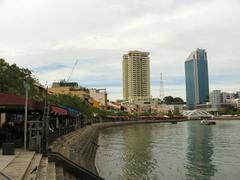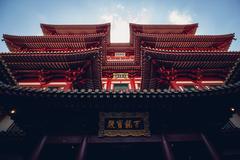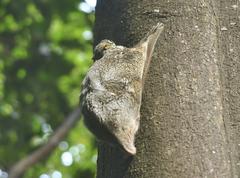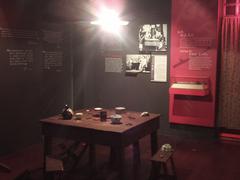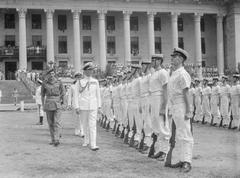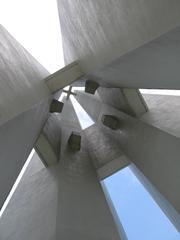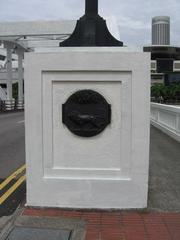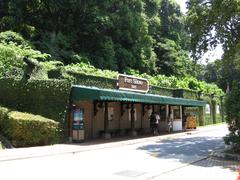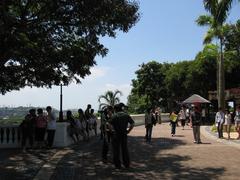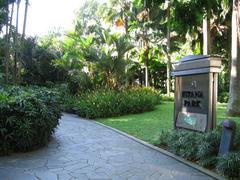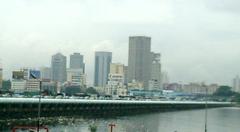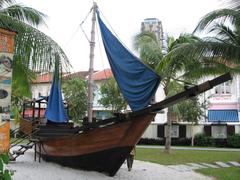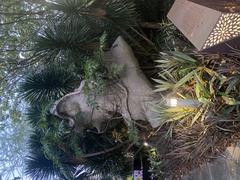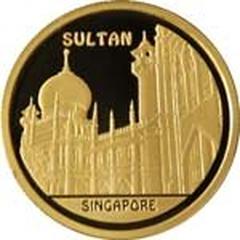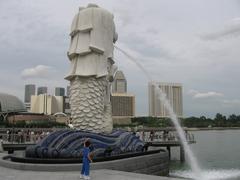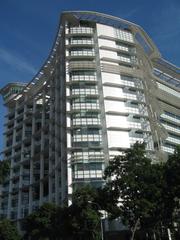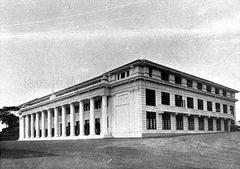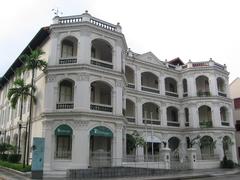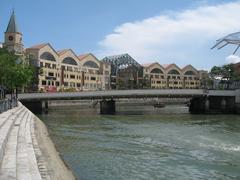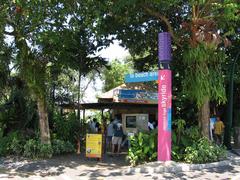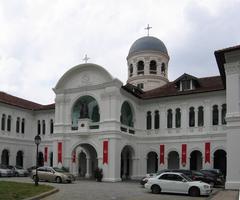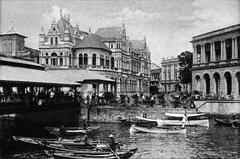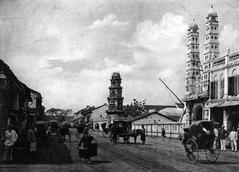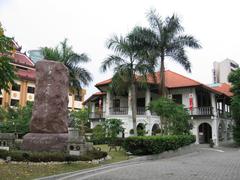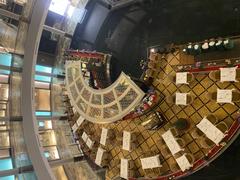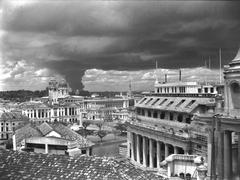Changi Chapel and Museum: Visiting Hours, Tickets, and In-Depth Guide to Singapore’s Historical Site
Date: 04/07/2025
Introduction
The Changi Chapel and Museum is one of Singapore’s most poignant historical landmarks, offering profound insights into the resilience, faith, and endurance of Allied prisoners of war (POWs) and civilian internees during the Japanese occupation (1942–1945). Located at 1000 Upper Changi Road North, the museum commemorates the experiences of over 50,000 individuals confined within Changi Prison and its surrounding camps. Through meticulously curated exhibitions, original artifacts, and immersive multimedia installations, the museum not only preserves the memory of suffering but also celebrates the enduring human spirit (Wikipedia; Singart).
This guide provides essential information on Changi Chapel and Museum visiting hours, ticketing, accessibility, and guided tours, as well as historical context and practical tips to enrich your experience at one of Singapore’s most significant World War II sites.
Table of Contents
- Introduction
- History and Significance
- Collections and Exhibition Highlights
- Visitor Information
- Tips for an Enriching Visit
- Frequently Asked Questions
- Conclusion
- References
History and Significance
World War II Origins
After the British surrender in 1942, the Changi area became the largest POW complex in Southeast Asia, with more than 50,000 Allied servicemen and civilians interned in brutal conditions. Despite strict surveillance and scarcity of resources, POWs were permitted to organize religious services, leading to the construction of makeshift chapels using salvaged materials (Wikipedia). These chapels became sanctuaries of solace, hope, and communal support.
Role of the Chapels
The chapels, including replicas of St George’s Church and the iconic Changi Chapel, were built from scrap wood, tin, and other found items. They served as spiritual and social hubs, bringing together denominations and nationalities in unity. The Changi Cross—a brass cross crafted from an artillery shell by POW Harry Stogden—remains a powerful symbol of faith and ingenuity (Wikipedia; Singart).
Memorialization and Relocation
Post-war, the original chapels were dismantled. Notably, the Roman Catholic chapel was relocated to Australia and reconstructed at the Prisoner of War National Memorial in Canberra. In Singapore, a replica chapel and small museum were first established in 1988. Due to Changi Prison’s expansion, the museum was moved to its current location and reopened in 2001, coinciding with the anniversary of Singapore’s fall (Remember Singapore; Around the World 4U).
Modernization and Reopening
Between 2018 and 2021, the museum underwent significant revitalization under the National Heritage Board. Enhanced with interactive exhibits, oral histories, and a recreated Changi Gaol cell, the museum reopened to the public in May 2021, further strengthening its educational and commemorative mission (Wikipedia; Little Day Out).
Collections and Exhibition Highlights
The museum is organized into eight thematic galleries, each illuminating a different facet of Changi’s wartime narrative:
- Changi Fortress: Strategic importance and pre-war context.
- Fallen Fortress: The British surrender and Japanese occupation.
- The Interned: Profiles and stories of POWs and civilian internees.
- Life as POW: Daily routines, survival, and hardship.
- Resilience in Adversity: Acts of courage and solidarity.
- Creativity in Adversity: Artistic expression and ingenuity under duress.
- Liberation: The end of occupation and return to freedom.
- Legacies: The lasting impact of the Changi experience (Little Day Out; TheSmartLocal).
Notable Artifacts
- The Changi Cross: A brass cross made from artillery shell fragments.
- Personal Diaries & Letters: Including a 400-page diary written to a POW’s wife.
- Stanley Warren’s Murals: Replicas of biblical murals painted under dire conditions.
- Handcrafted Items: Tools, games, and a ventriloquist doll known as Joey, hidden from the captors (TheSmartLocal).
Immersive Experiences
- Recreated Prison Cell: Step inside to experience the cramped conditions of internees, enhanced by audio recordings of real prisoner stories (TheSmartLocal).
- Interactive Multimedia: Oral histories, digital archives, and touchscreens deepen engagement.
- Virtual Tours: Available on the museum’s website for pre-visit or remote exploration.
Visitor Information
Opening Hours & Admission
- Tuesday – Sunday: 9:30 am – 5:30 pm (last admission 5:00 pm)
- Closed: Mondays (except Public Holidays)
- Admission:
- Singapore Citizens & PRs: Free
- Foreign Visitors: Check current rates (Official Info)
- Children (6 and under): Free for all
- Tickets can be bought online or at the entrance. Advance booking is recommended on weekends and during special events (ShrugMyShoulder).
Accessibility
- Wheelchair accessible: Ramps, lifts, and accessible restrooms throughout.
- Additional support: Braille labels, tactile exhibits, and audio guides for visitors with sensory needs.
- Assistance: Staff are available to help upon request.
Guided Tours
- Free Public Tours: In English and Mandarin, bookable online in advance.
- Robot Guide (Temi): Interactive tours with a robot roleplaying as a POW; available select weekdays (TheSmartLocal).
- School & Group Tours: Custom programs are available; email [email protected] for arrangements.
Directions & Parking
- MRT:
- East West Line to Tanah Merah or Expo; transfer to bus or taxi.
- Downtown Line to Upper Changi (DT34), then bus 2 to “Opposite Changi Chapel Museum”.
- Bus:
- Bus numbers 2 and 29 stop at “Changi Chapel Museum” (97209).
- Car/Taxi:
- Limited on-site paid parking: S$1.20/hour (day), S$3/entry (night), motorcycles S$0.65/entry (Visitor Info PDF).
- Drop-off and pick-up grace period: 10 minutes.
Facilities
- Restrooms: Fully accessible.
- Gift Shop: Heritage-themed souvenirs available (NHB Shop).
- No food or drink in galleries; nearby eateries accessible by car or public transport.
- Air-conditioned galleries and shaded outdoor areas for comfort.
Nearby Attractions
- Changi Beach Park
- Changi Air Base Museum
- Battlebox at Fort Canning Park
- National Museum of Singapore
- Bukit Chandu Museum (ShrugMyShoulder)
Tips for an Enriching Visit
- Best time to visit: Mornings and weekdays are quieter.
- Duration: Allocate at least 1.5–2 hours.
- Dress code: Modest attire recommended.
- Photography: Allowed in most areas; avoid flash and tripods.
- Pre-booking: Reserve tickets online, especially during peak periods.
- Weather preparedness: Bring water, sunscreen, and an umbrella due to Singapore’s climate.
Frequently Asked Questions (FAQs)
Q: Are tickets available online?
A: Yes, online booking is recommended, especially during busy periods (Visitor Information).
Q: Is the museum suitable for children?
A: Yes, with free entry for children 6 and below; educational programs are available.
Q: Is the museum wheelchair accessible?
A: Fully wheelchair accessible, with additional aids for sensory impairments.
Q: Can I take photographs inside?
A: Yes, except in some sensitive areas; flash and tripods are generally not permitted.
Q: Are guided tours available?
A: Yes, free public and group tours are offered; robot-guided tours are available on select days.
Q: Is parking available?
A: Limited paid parking onsite; public transport is recommended.
Conclusion
The Changi Chapel and Museum provides a moving and educational journey into Singapore’s wartime past, highlighting personal stories of courage, resilience, and hope. With its rich exhibits, interactive galleries, and accessible facilities, it stands as both a place of remembrance and a hub for learning. Plan your visit by checking the latest opening hours and ticket information, consider joining a guided tour, and explore digital resources such as virtual tours and audio guides. For a deeper understanding of Singapore’s heritage, combine your visit with other nearby historical sites.
For further details or to book tickets, visit the Changi Chapel and Museum official website.
References
- Changi Chapel and Museum, Wikipedia
- Visiting Changi Chapel and Museum: History, Tickets, Hours, and Tips, Singart
- Visiting Changi Chapel and Museum, Around the World 4U
- Changi Chapel and Museum Explore the Past Through Artefacts & Stories, Little Day Out
- Visiting the Changi Chapel and Museum, History Hit
- Changi Chapel and Museum Visitor Guide, National Heritage Board (NHB)
- Changi Chapel and Museum, TheSmartLocal
- Remember Singapore: Changi Chapel Museum Tour
- ShrugMyShoulder, personal visit experience
- Changi Chapel and Museum, Official Visitor Guide PDF
- Changi Chapel & Museum, Trip.com
- Traveloka Guide
- ForeverVacation
- The New Age Parents
- NHB, Shop for Heritage
- Medium, Singapore Travel
- Singapore Trip Guide
- CheQin.ai



